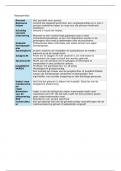Samenvatting
Summary Molecular Genetics
- Instelling
- Rijksuniversiteit Groningen (RuG)
This is a summary of the lectures of Molecular Genetics, a mandatory course for biomedical science students that are in the second year of the study Biology at the RUG. With this summary (and the shorter version I made) I was able to get a 9.0 for this exam. Especially understanding the pictures he...
[Meer zien]













